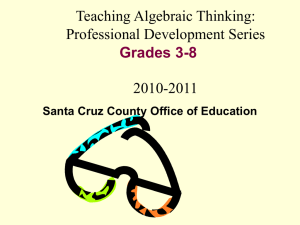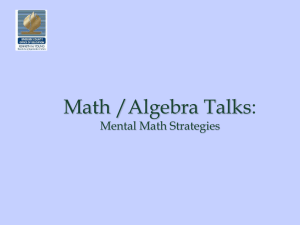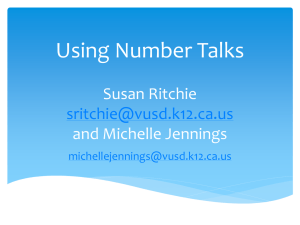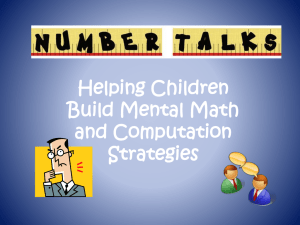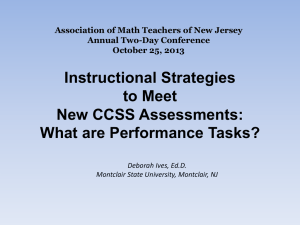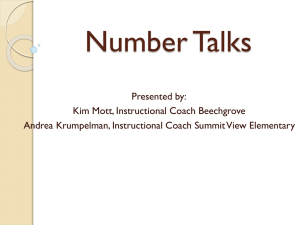NCTM Overview for ASSM - Minnesota Council of Teachers of
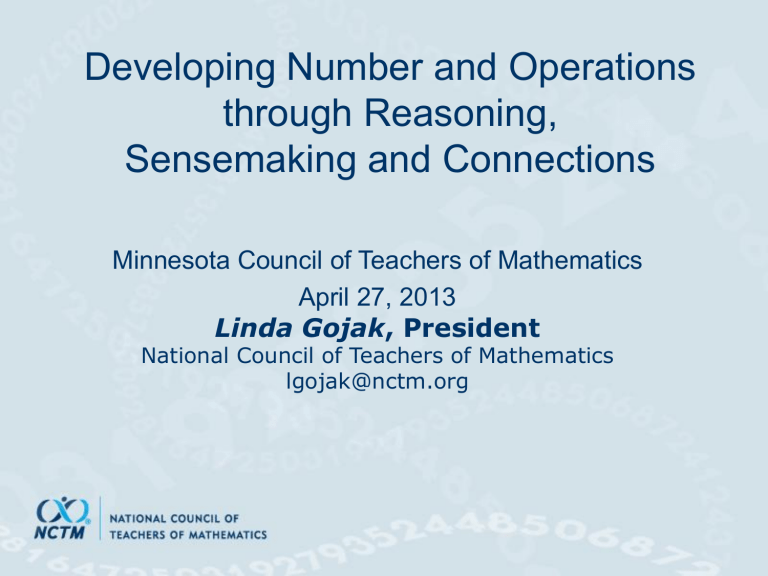
Developing Number and Operations through Reasoning,
Sensemaking and Connections
Minnesota Council of Teachers of Mathematics
April 27, 2013
Linda Gojak, President
National Council of Teachers of Mathematics lgojak@nctm.org
A Vision for Mathematics Education
NCTM Process Standards
– Connections
– Communication
– Problem Solving
– Reasoning and Proof
– Representation
National Research Council ’s
Strands of Proficiency
Adding It Up , 2001
• Adaptive Reasoning
• Strategic Competence
• Conceptual
Understanding
• Productive Disposition
• Procedural Fluency
8 CCSSM Mathematical Practices
1. Make sense of problems and persevere in solving them.
2. Reason abstractly and quantitatively.
3. Construct viable arguments and critique the reasoning of others.
4. Model with mathematics.
5. Use appropriate tools strategically.
6. Attend to precision.
7. Look for and make use of structure.
8. Look for and express regularity in repeated reasoning.
7 .
Seven Habits of Highly Effective
Mathematics Teachers
1. Flexible
2. Collaborative
3. Think about mathematics strategically
4. Risk taker
5. Ask good questions
6. Listener
7. Reflective
Flexibility
• If we want students to be flexible thinkers then teachers must be able to think flexibly.
– Number Talks
• http://insidemathematics.org
• http://mathperspectives.com/num_talks.ht
ml
What is a Number Talk?
• A short, ongoing daily routine that provides students with meaningful ongoing practice with computation
• a powerful tool for helping students develop computational fluency because the expectation is that they will use number relationships and the structures of numbers to add, subtract, multiply and divide .
Why Number Talks?
• Develop Number Sense
• Develop Fluency
• Encourage Strategic Thinking
(Reasoning)
• Use Various Representations
Six step format of a number talk
Step 1: Teacher presents the problem.
Step 2: Students have time to figure out the answer .
Step 3. Students share their answers.
Step 4. Students share their thinking.
Step 5. The class agrees on the correct answer for the problem.
Step 6. The steps are repeated for additional problems.
Integrating Number Talks into a Lesson
• Number Talks should be structured as short sessions alongside (but not necessarily directly related to) the ongoing math curriculum.
• It is important to keep Number Talks short, as they are not intended to replace current curriculum. In fact, teachers need to spend only 5 to 10 minutes on Number Talks.
• Number Talks are most effective when done everyday.
Number Talk with Fractions
5
-
2
3
5
Strategic Thinking
• In mathematics, everything you do should make sense.
– Multiple representations
• Concrete (materials)
• Pictorial (semi-concrete)
• Semi-abstract (number lines, models)
• Abstract (symbolic)
– Check for reasonable solutions
• Benchmarks
• Estimation Strategies
Concrete/Pictorial
Semi abstract
Abstract
3 x 4 = 12
“3 groups of 4 is the same as 12”
Make connections among mathematical ideas explicit
9
÷
3
9
10
3
÷
10
0.9 ÷ 0.3
Use Benchmarks
1
2
+
2
3
=
7
8
÷
1
4
16 x 0.05
39.5 x 0.95
436.2 ÷ 0.63
82.5 ÷ 1.2
Strategic Thinking
Taking Risks
Use rich tasks
– Strategy games
• Close to 1
– Good Problems
• Introduce or build a concept
– Naked Number tasks
• Number talks
Close to 1
Use 4 of the cards below to make 2 fractions whose some is closest to 1.
Perimeter
• Build all of the rectangular puppy pens using 16 feet of fencing without using any fractions or decimals.
Ask students clarifying questions
• What do you know so far?
• What are you wondering about?
• What have you tried so far?
• Can you draw a picture of what is happening?
• Can you try this with simpler numbers?
• What tools might you use to help you?
• Is your answer reasonable? How do you know?
Questions to promote classroom conversations
• Who would like to share their thinking?
• What was the first thing your eyes saw, or your brain did?
• Convince me.
• How did you figure that out?
• Billy, can you tell us where you got that 5?
• How many people solved it the same way as Billy?
Questions to promote classroom conversations
– Who used another strategy?
– How is your strategy like Billy’s? How is it different?
– Will your strategy always work? Can you find a time when it doesn’t work?
AVOID
– Questions that can be answered by yes or no
– Asking “Do you understand?”
– www.pbs.org/teachers/_files/pdf/TL_MathCard.pdf
Listen to the students
Allow them to show and tell….
Reflective Thinking
• What happened in the lesson?
• What do my students know?
• What are my students still struggling with?
• How will I address that tomorrow?
• What connections can I make between today’s lesson and what I want to do tomorrow?
Formative Assessment
• Can come from student responses and work during class
• Warm up activity
• Exit slips
• Quick write
• Number talks
(see NCTM research brief at www.nctm.org)
